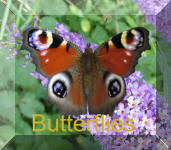Identification
Large: wingspan, 70-75 mm.
The silver-washed fritillary is named after the silver streaks on the undersides
of the wing. It has a rapid, swooping flight. Males are a spectacular
orange brown with black patterning on the upper side of the wings. Both
fore and hind wings have complex patterning which include a double row
of black spots to the inside of a black scalloped wing margin. To the inside
of the double row of spots there are further black markings that take the
form of irregular elongate angular blotches. Males also have four black
scent glands in the centre of their forewings that run along underlying
main veins. The underside of the forewings reflect the colour patterning
of the upper surface except for at the wing tip where the ground colouration
becomes paler and the patterning a greenish grey. The underside of the
hind wings do not reflect the upper side patterning but are replaced by
a greenish grey ground colour interrupted by a number of irregular wavy
white stripes.
IMAGES COURTESY OF STEVE SHROUD (C)
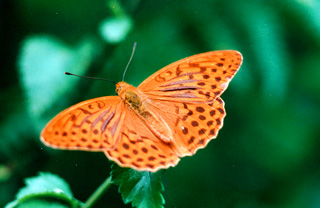
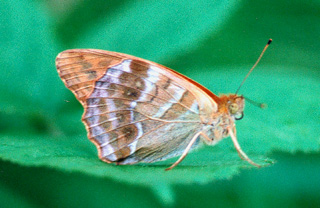
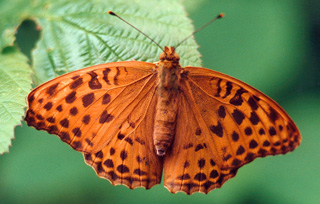
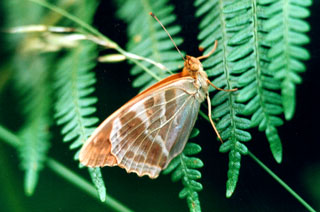
Females are similarly patterned to the males but lack the scent glands of the fore wings. Their ground colour is a duller brown.
Behaviour and life history
Caterpillars feed on common dog-violet growing in woodlands. Adult butterflies feed on the nectar of brambles.The species is most often to be seen either flying strongly along woodland edges, feeding on brambles in particular or else sunning itself on a vantage point in its territory. Males aggressively defend their territory from other males. Eggs are laid on the bark of trees in the immediate vicinity of their larval foodplant, the Common Dog Violet, Viola riviniana. The young caterpillars remain on the trucks and branches where they overwinter before descending in the spring to feed on the Common Dog Violet. The caterpillars pupate over June before the adults emerge in July
Distribution and status
The silver-washed fritillary (Argynnis paphia) is a Species of Conservation Concern in Britain. Changes in woodland management in recent years have led to the decline of this once common species. It was widespread across England and Wales, but is now found in southern and south-western England.

